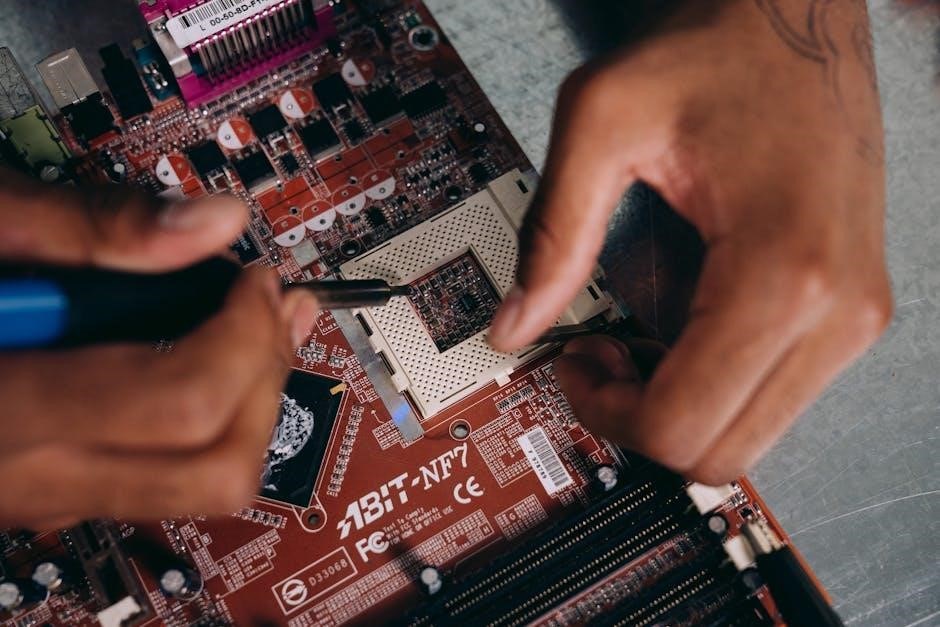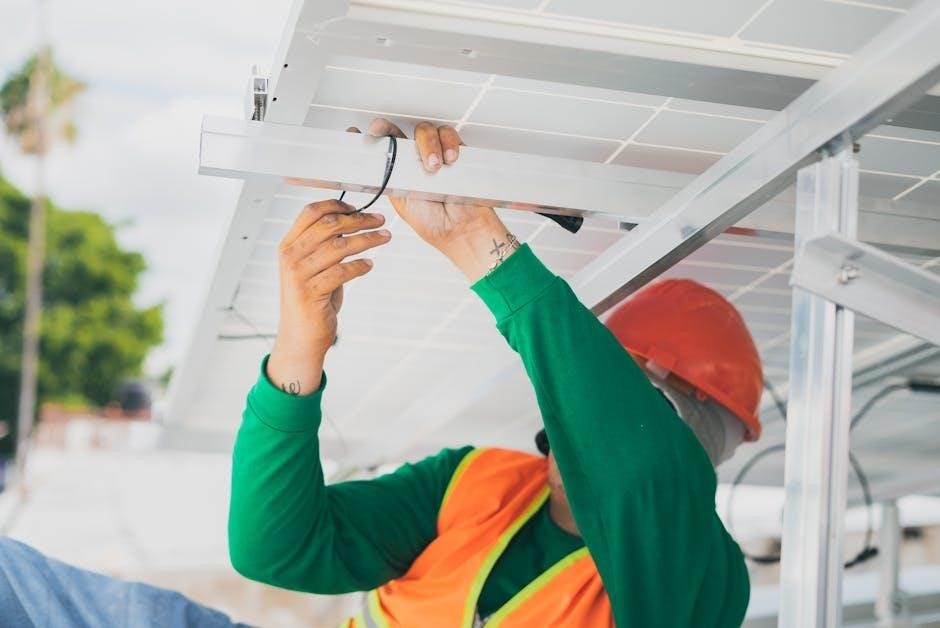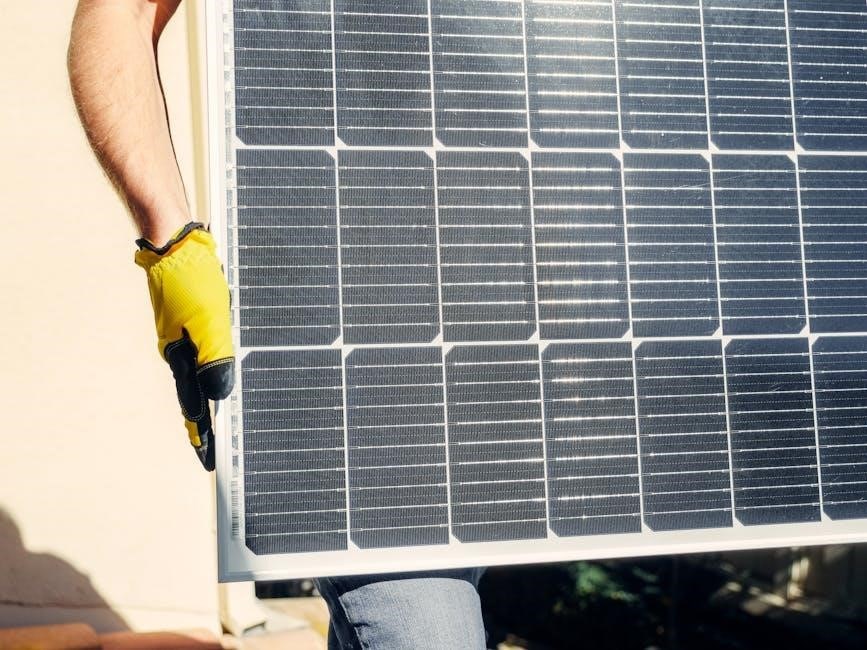This manual provides a comprehensive guide for installing the Bendix/King KX 155 Nav/Comm system, covering key components, installation steps, and compliance with safety standards for optimal performance.

System Components
The KX 155 system includes a control head, display unit, communication and navigation antennas, microphone, and headphones, all designed for seamless integration and reliable performance in aviation environments.
2.1. Control Head
The control head is the primary interface for operating the KX 155 system, featuring a user-friendly design with buttons, knobs, and an LCD display for navigation and communication. It enables pilots to input frequencies, monitor transmissions, and adjust settings seamlessly. The control head is typically mounted in an accessible location, such as the instrument panel or a side console, to ensure ease of operation. Its durable construction ensures reliability in various flight conditions. Proper installation involves securing it firmly to prevent vibration or movement, which could affect performance. The control head also includes backlighting for readability in low-light environments, enhancing safety and functionality during nighttime or IFR operations. Ensure all connections to the display unit and antennas are secure for optimal functionality. This component is critical for efficient communication and navigation, making it essential to install and configure it correctly.
2.2. Display Unit
The display unit of the KX 155 system serves as the visual interface, providing critical navigation and communication data to the pilot. Typically, it features a high-resolution LCD screen that displays frequency information, mode status, and signal strength. The display unit is designed to be compact and lightweight, allowing for flexible installation in various cockpit configurations. It is usually mounted in clear view to ensure readability during flight operations. Proper installation requires secure fastening to prevent vibration or dislodgment. The display unit connects directly to the control head and relies on a stable power supply for consistent performance. Ensure correct alignment and protection from direct sunlight to maintain optimal visibility. Regular cleaning of the screen is recommended to avoid glare and preserve clarity. This unit is essential for effective system operation, making accurate installation and configuration paramount for reliable functioning.
2.3. Antennas
The KX 155 system requires properly installed antennas to ensure optimal performance. Two primary antennas are typically used: one for communication and another for navigation. These antennas are designed to be durable and resistant to environmental factors such as moisture and temperature changes. They are usually constructed from high-quality materials like stainless steel or fiberglass for longevity. Proper placement is critical to avoid signal interference and ensure clear transmission and reception. Antennas should be mounted externally, away from obstructions, and aligned correctly to maximize signal strength. Secure all connections tightly to prevent loose fittings, which can degrade performance. Regular inspection of the antennas is recommended to identify any damage or corrosion. Proper installation and maintenance of the antennas are vital for reliable system operation and accurate communication. Follow the manufacturer’s guidelines for installation to achieve optimal results.

Installation Requirements
The KX 155 installation requires careful planning, including compatible system integration, adequate space, and proper power supply. Ensure environmental conditions align with manufacturer specifications for optimal performance and reliability.
3.1. Physical Specifications
The KX 155 system requires specific physical accommodations to ensure proper installation and functionality. The control head measures approximately 6.25 inches in width, 4.5 inches in height, and 11.75 inches in depth. Mounting should be done on a stable surface, avoiding excessive vibration or movement. The display unit must be installed in a visible location for optimal readability, with a recommended viewing distance of 24-36 inches. Environmental factors, such as temperature and humidity, must align with manufacturer guidelines to prevent damage. Ensure all components are securely fastened using the provided hardware. Proper spacing around the unit is essential for heat dissipation and maintenance access. Refer to the manual for precise measurements and installation guidelines to guarantee a reliable setup.
3.2. Mechanical Considerations
When installing the KX 155 system, mechanical considerations are critical for ensuring stability and performance. The control head and display unit must be mounted on a rigid, vibration-resistant surface to prevent mechanical stress. Use the provided mounting brackets and ensure all fasteners are tightened securely. Avoid over-tightening, as this may damage the unit. The system should be installed in a location with minimal exposure to direct sunlight or extreme temperatures. Ensure proper alignment of connectors and cables to avoid mechanical strain. Additionally, verify that the mounting surface can support the weight of the components. Regularly inspect the installation for any signs of wear or loosening of connections. Proper mechanical setup ensures reliable operation and extends the lifespan of the system.
3.3. Electrical Requirements
The KX 155 system requires a stable power supply to function correctly. Ensure the aircraft’s electrical system provides a regulated 12 VDC or 24 VDC power source, with a maximum ripple of 10%. The system draws a nominal current of 2.5 A during operation. Connect the power leads to a dedicated circuit breaker or fuse, rated appropriately to handle the maximum current. Use the recommended wiring gauge to minimize voltage drop. Ground the system properly to avoid electrical noise and interference. Ensure all connections are secure and comply with aviation standards. Avoid sharing the power source with high-current devices to prevent fluctuations. Adhere to these electrical requirements to ensure reliable operation and prevent damage to the system components.
3.4. Environmental Considerations
The KX 155 system must be installed in an environment that meets specific conditions to ensure optimal performance. The operating temperature range is -20°C to 55°C, and the unit should be protected from direct sunlight, moisture, and extreme humidity. Avoid installing the system in areas exposed to corrosive chemicals or high levels of vibration. Ensure proper ventilation to prevent overheating. The system is designed to withstand typical aircraft vibration, but it must be securely mounted to prevent damage. Ground the unit properly to avoid static discharge. Do not install in compartments with standing water or high condensation. Adhering to these environmental considerations ensures reliable operation and extends the system’s lifespan. Always follow aviation standards for environmental compatibility during installation.

Wiring and Connectivity
Proper wiring and connectivity are crucial for the KX 155 system to function correctly. Use the supplied connectors and ensure all cables are securely attached to prevent signal loss or interference. Regularly inspect wires for damage or wear. Follow the wiring diagram to connect components accurately. Ensure all connections are tight and meet aviation standards. Proper grounding is essential to avoid electrical noise. Use shielded cables for sensitive connections to maintain signal integrity. Avoid crossing wires near high-current systems to prevent interference. Test all connections before powering on the system to ensure reliability and safety during operation.
4.1. Wiring Diagrams
The wiring diagrams provided in the KX 155 installation manual are essential for ensuring proper connections between system components. These diagrams detail the correct wiring paths, connector pin assignments, and circuit configurations. Use the diagrams to identify the appropriate wires for power supply, data transmission, and antenna connections. Color-coding and labels on the wires should match the diagram for accuracy. Verify each connection against the diagram to avoid mismatches. Pay attention to grounding points, as improper grounding can lead to system malfunctions. Refer to the diagrams for specific instructions on connecting the control head, display unit, and antennas. Follow the wiring layout carefully to maintain signal integrity and ensure compliance with aviation standards. Accurate adherence to these diagrams is critical for reliable system operation.
4.2. Connectivity Steps
Connectivity steps for the KX 155 system involve linking the control head, display unit, and antennas to ensure seamless communication. Begin by connecting the control head to the display unit using the designated data cable. Ensure the connectors are securely fastened to prevent loose connections. Next, attach the communication and navigation antennas to their respective ports on the control head. Use the wiring diagrams as a reference to confirm the correct pin assignments. Connect the power supply wires to the system, ensuring the voltage matches the specified requirements. Finally, verify all connections by powering on the system and performing a basic functionality test. Proper connectivity is critical for optimal performance. Follow these steps carefully to avoid signal loss or system malfunctions.
4.3. Best Practices
Best practices for the KX 155 installation ensure reliability and optimal performance. Always ground the system properly to prevent electrical noise. Use high-quality cables and connectors to minimize signal degradation. Follow the wiring diagrams precisely to avoid misconnections. Power on the system gradually, starting with the control head, then the display unit, and finally the antennas. Label all cables clearly for easy identification and future maintenance. Regularly inspect connections and cables for wear or damage. Perform thorough testing after installation to ensure all components function correctly. Adhere to safety guidelines to prevent damage to the system or personal injury. By following these practices, you can ensure a smooth and reliable installation process for the KX 155 system.

Antenna Configuration
Proper antenna configuration is crucial for optimal system performance. Ensure correct alignment and placement to maximize signal strength and minimize interference. Follow guidelines for installation.
5.1. Communication Antenna
The communication antenna is essential for transmitting and receiving radio signals. Mount it on the aircraft’s exterior, ensuring minimal obstruction. Use a quarter-wave whip or blade antenna, tuned to the operational frequency range. Secure the antenna firmly to prevent vibration damage. Ensure proper grounding to avoid signal loss and interference. The antenna should be positioned away from other aircraft systems to maintain optimal performance. Follow the manufacturer’s guidelines for specific installation requirements, such as cable routing and connector types. Proper alignment and polarization are critical for maximizing signal strength and clarity. Test the antenna after installation to ensure it meets performance specifications. Refer to the manual for detailed tuning procedures. Always use approved tools and materials to avoid compromising the system’s integrity.
5.2. Navigation Antenna
The navigation antenna is crucial for receiving VOR (VHF Omnidirectional Range) and LOC (Localizer) signals. Install it in a location with an unobstructed view of the horizon, typically on the aircraft’s belly or wing. Use a blade-type or rod-style antenna, ensuring it is compatible with the KX 155 system. Proper grounding is essential to minimize interference and ensure accurate signal reception. The antenna should be aligned with the aircraft’s compass for correct navigation data. Avoid mounting near other antennas or metal structures that could cause signal interference. After installation, perform a signal strength test to ensure optimal performance. Use approved materials and follow the manufacturer’s guidelines for secure mounting and cable connections. Proper installation ensures reliable navigation during flight operations.
5.3. Installation Tips
Ensure all components are properly grounded to minimize interference. Use high-quality cables and connectors to maintain signal integrity. Plan the installation carefully, considering the aircraft’s wiring and avionics system. Verify compatibility with existing systems before starting. Mount antennas in locations with minimal obstruction for optimal performance. Follow the manufacturer’s torque specifications for connectors and fasteners. Test each connection as you go to identify potential issues early. Use heat shrink tubing or adhesive-lined connectors to protect against moisture. Keep documentation handy for quick reference during installation. Avoid over-tightening cables, as this may damage the wiring. Double-check all connections before powering on the system. Regularly inspect cables and connectors for signs of wear or damage. Follow FAA guidelines for avionics installations to ensure compliance and safety.

Testing and Validation
Perform thorough tests to ensure proper system functionality. Conduct power-on checks, verify signal strength, and validate communication and navigation features. Ensure all components operate within specifications.
6.1. Initial Power-On Tests
Begin by powering on the KX 155 system and observing the control head for LED indicators. Ensure the display illuminates and performs a self-test sequence. Verify that all buttons and knobs function correctly. Check for any error messages or alarms, which may indicate issues with installation or component connectivity. If the system fails to power on, inspect the power supply connections and ensure proper wiring. Consult the manual for specific error codes and troubleshooting steps. Repeat the process after addressing any identified issues to confirm resolution. Always follow the manufacturer’s guidelines for initial testing to ensure system reliability and performance. This step is critical for identifying and resolving installation errors early.
6.2. Signal Strength Tests
After powering on the system, conduct signal strength tests to ensure optimal communication and navigation performance. Use the display unit to monitor signal strength indicators for both communication and navigation antennas. Verify that the signal levels fall within the acceptable range specified in the manual. Perform tests under normal operating conditions and in various environments to assess consistency. If signal strength is weak, inspect antenna connections and positioning. Adjust antennas to achieve maximum reception. Additionally, use an external signal strength meter if available. Document the results for future reference. Ensure all tests are conducted in accordance with the manufacturer’s guidelines to guarantee accurate readings. Proper signal strength is crucial for reliable system operation.
6.3. Functional Verification
Once the system is powered on and signal strength is confirmed, perform functional verification to ensure all components operate seamlessly. Test the control head, display unit, and antennas by transmitting and receiving signals. Verify that the display accurately shows communication and navigation data. Check the functionality of all buttons, knobs, and menu options on the control head. Ensure the navigation system provides accurate location and direction data. Test the system’s ability to switch between communication and navigation modes smoothly. Confirm that all alarms and alerts function correctly. Perform these tests under various conditions to simulate real-world usage. If any component fails to perform as expected, refer to the troubleshooting section. Proper functional verification ensures the system is ready for reliable operation.

Troubleshooting
Troubleshooting involves identifying and resolving system malfunctions. Start by checking connections and configurations. Refer to error codes for specific issues. Perform diagnostic tests to isolate faults. Use the manual’s guidance for repair procedures. If unresolved, contact certified support for assistance.
7.1. Common Issues
Common issues during KX 155 installation include power malfunctions, connectivity problems, and configuration errors. Ensure the system is properly grounded and power sources are stable. Check antennas for correct placement and damage, as poor signal strength can disrupt communication. Verify all cables are securely connected and free from damage. If the display unit fails to power on, inspect the power cord and circuit breakers. For software-related issues, restart the system or perform a factory reset. Consult the manual for specific error codes and solutions. If problems persist, contact certified technical support for assistance. Regular maintenance and updates can help prevent recurring issues.
7.2. Advanced Troubleshooting Techniques
Advanced troubleshooting for the KX 155 involves diagnosing complex system malfunctions. Use diagnostic tools to analyze signal strength and system performance. Check for interference from nearby electronic devices and ensure antennas are properly tuned. Perform a loop-back test to isolate communication issues between components. Inspect connectors for corrosion or damage, as this can disrupt data transmission. Reset the system to factory settings if software glitches persist. Use multimeters to verify voltage levels at critical points. If issues remain unresolved, consult the troubleshooting matrix in the manual or contact a certified technician. Advanced techniques require precision and a thorough understanding of the system’s architecture. Always follow safety protocols when working with electrical components.

Safety Considerations
Ensure proper grounding to prevent electrical hazards. Avoid exposing components to extreme temperatures or moisture. Follow aviation standards for installation and operation. Always disconnect power before servicing. Wear protective gear when handling electrical systems to minimize injury risks.
8.1. General Safety Precautions
Always follow proper safety protocols when installing the KX 155. Ensure the aircraft is grounded to prevent static discharge. Disconnect power sources before servicing. Use appropriate tools and avoid damaged components. Wear protective eyewear and ensure a clean, well-ventilated workspace. Adhere to aviation regulations and manufacturer guidelines. Avoid exposing the system to extreme temperatures or moisture. Keep flammable materials away from installation areas. Ensure all connections are secure to prevent electrical arcing. Follow proper procedures for handling sensitive electronics. Regularly inspect wiring and components for damage. Use certified equipment and comply with safety standards to maintain system reliability and operator safety. Never bypass safety features or ignore warning indicators during installation or operation.
8.2. Emergency Procedures
In case of an emergency during or after installation, follow established protocols to ensure safety. If a system malfunction occurs, disconnect power immediately and avoid further interaction. For electrical issues, isolate the circuit breaker or switch. In case of fire, use a fire extinguisher rated for electrical fires. Evacuate the area and alert others if necessary. For software or firmware failures, reset the system or reinstall the latest version. Document any incidents and contact technical support for assistance. Always prioritize personal safety and avoid risky repairs without proper training. Keep emergency contact information readily available. Regularly review emergency procedures to ensure preparedness. Adhere to aviation safety guidelines and best practices for handling unexpected situations.

Maintenance and Updates
Regular maintenance ensures optimal performance and safety. Schedule routine checks, update software, and verify compliance with aviation standards. Follow manufacturer guidelines for longevity and reliability.
9.1. Routine Maintenance
Perform routine maintenance to ensure the KX 155 system operates efficiently. Regularly clean the control head and display unit to prevent dust buildup, which may affect performance. Inspect all electrical connections and antennas for damage or corrosion, addressing any issues promptly. Power cycle the system monthly to clear temporary glitches. Check for loose screws or mounts, especially after aircraft movements, to maintain stability. Use a soft cloth and mild cleaning agents to avoid damaging sensitive components. Document all maintenance activities for future reference. Always refer to the manufacturer’s guidelines for specific procedures and recommendations. Proper upkeep ensures reliability, safety, and optimal functionality of the KX 155 system.
9.2. Software and Firmware Updates
Regular software and firmware updates are essential to ensure the KX 155 system operates with the latest features and security patches. Always download updates from the manufacturer’s official website to avoid unauthorized modifications. Before updating, back up system configurations to prevent data loss. Follow the installation instructions carefully, ensuring the aircraft is grounded to prevent interference. After updating, reboot the system and verify proper functionality. Consult the manual for specific update procedures, as improper installation may void warranties or cause system malfunctions. Updates may also improve compatibility with other avionics systems. Manufacturer support is available for assistance with complex update processes.
9.3. Compliance and Certification

Ensuring compliance with regulatory standards is critical for the KX 155 installation. The system must adhere to Federal Aviation Regulations (FARs) and obtain proper certification from aviation authorities. All components, including antennas and wiring, must meet specified standards to avoid non-compliance issues. Post-installation, conduct a thorough inspection to verify adherence to certification requirements. Maintain detailed documentation, including installation records and test results, for submission to regulatory bodies. Failure to comply may result in operational restrictions or legal penalties. Always refer to the latest certification guidelines for updates or changes in requirements. Proper certification ensures safe and legal operation of the KX 155 system in aviation environments.
